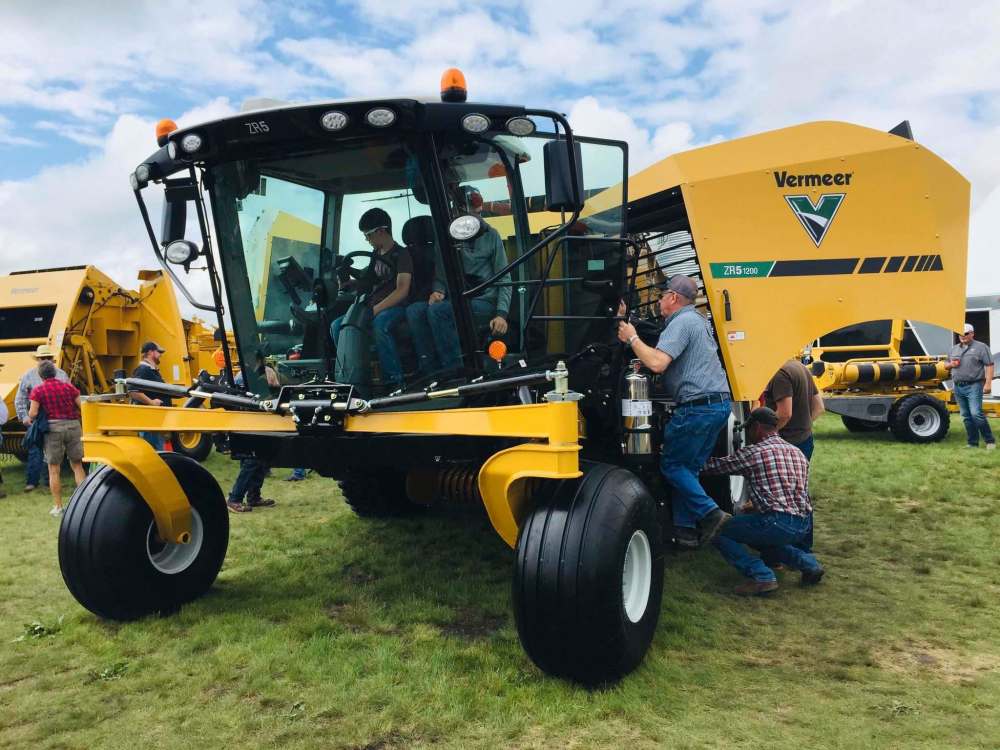Self-propelled baler makes foraging look fun
Vermeer ZR5 is efficient and safe, but comes at a price
Advertisement
Read this article for free:
or
Already have an account? Log in here »
To continue reading, please subscribe:
Monthly Digital Subscription
$0 for the first 4 weeks*
- Enjoy unlimited reading on winnipegfreepress.com
- Read the E-Edition, our digital replica newspaper
- Access News Break, our award-winning app
- Play interactive puzzles
*No charge for 4 weeks then price increases to the regular rate of $19.00 plus GST every four weeks. Offer available to new and qualified returning subscribers only. Cancel any time.
Monthly Digital Subscription
$4.75/week*
- Enjoy unlimited reading on winnipegfreepress.com
- Read the E-Edition, our digital replica newspaper
- Access News Break, our award-winning app
- Play interactive puzzles
*Billed as $19 plus GST every four weeks. Cancel any time.
To continue reading, please subscribe:
Add Free Press access to your Brandon Sun subscription for only an additional
$1 for the first 4 weeks*
*Your next subscription payment will increase by $1.00 and you will be charged $16.99 plus GST for four weeks. After four weeks, your payment will increase to $23.99 plus GST every four weeks.
Read unlimited articles for free today:
or
Already have an account? Log in here »
Hey there, time traveller!
This article was published 20/07/2019 (2327 days ago), so information in it may no longer be current.
SASKATOON — The Vermeer ZR5 self-propelled baler is the type of machine that makes the annual task of putting up livestock forage for the winter look fun.
For the most part, baling isn’t much fun. It’s a yearly necessity for people feeding livestock and it is fraught with perils such as equipment breakdowns, quality losses and safety issues. Rain makes hay, but it also wrecks it, depending on when it falls.
Provincial statistics show this year’s hay crop is poor, largely due to the lack of moisture and cool conditions early in the growing season. For many of Manitoba’s cattle producers, the question is not if they will have to sell off part of their herds, it’s how many and when to pull the plug.

Against that backdrop, Vermeer was showcasing the latest innovation in balers at this week’s Ag in Motion (AIM), a massive display of technology that springs up from the prairie northwest of Saskatoon for three days every July. The outdoor farm show draws farmers from around the world to see how agriculture is getting bigger, smarter and safer.
The Vermeer baler hits the mark on all three. First launched last year in the U.S., this is the first self-propelled baler to be commercialized that makes those large round bales you see scattered across hayfields this time of year. Unlike autonomous or driverless technology, this unit still requires an operator.
But being self-propelled means the operator is positioned high over the row of cut hay or straw as it is fed into the baler.
Traditional balers towed by tractors position the operator ahead of the windrow and off to one side, so the operator must constantly be looking back over his or her shoulder to make sure the forage is feeding into the baler properly.
That’s a huge advantage for comfort as well as safety, says Corey Dalman, Vermeer’s regional sales manager. Cameras positioned on the intake below and on the back of this unit allow the operator to monitor the forage feeding into the baler and then watch as the bound bale is ejected out the back. The rear camera also helps the operator see what’s coming up from behind when travelling down the road between fields.
Where it really shines for safety, however, is the fact that the operator cannot accidentally become entangled in the fast-spinning power-takeoff drive that connects tractors with traditional pull-type balers. Nor can they become entangled in the baler itself.
Both limbs and lives have been lost because operators fail to shut the unit down before leaning in to check something. Just as with a lawn mower, this baler stops as soon as the operator leaves the seat. “The engine stays running, but the baler shuts down,” Dalman said.
It also features zero-clearance turns, which increases the speed at which it can operate, and it has air-ride suspension, which means the unit operates more smoothly in rough terrain.
It all adds up to more efficiency. Dalman said side-by-side comparisons put this unit up against traditional baler-tractor combinations with similar scale and features.
“The two tractor-baler combinations in an hour and a half did 154 bales, and one of these all by itself did 132 in the same amount of time. It was a very good test in ideal conditions,” he said.
That means less equipment, less energy and less manpower needed to cover the same ground — an important feature when skilled labour is exceedingly hard to find in agriculture.
However, this kind of technology doesn’t come cheap. At a cost of just over $300,000, it’s a good fit for custom balers or producers putting up 5,000 round bales per year.
That’s approximately what a herd of about 500 head of cattle might consume depending on the weight of the bale and the number of months the producer must feed.
That’s if they need a baler at all.
Next week: a different kind of innovation in livestock-forage management, which was also on display at AIM.
Laura Rance is vice-president of content for Glacier FarmMedia. She can be reached at lrance@farmmedia.com.

Laura Rance is editorial director at Farm Business Communications.
Our newsroom depends on a growing audience of readers to power our journalism. If you are not a paid reader, please consider becoming a subscriber.
Our newsroom depends on its audience of readers to power our journalism. Thank you for your support.

